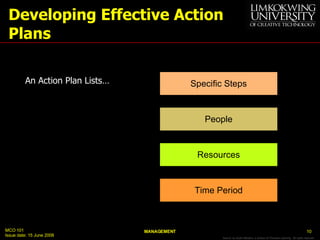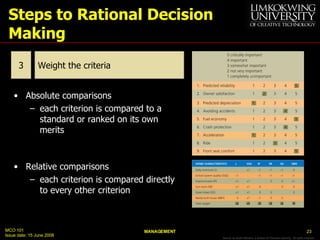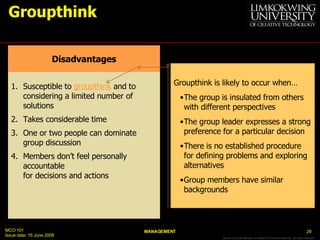MBA MCO101 Unit 4 Lecture 5 20080622
- 1. Unit 4: Decision-making and Planning
- 2. Managing Expectations LEARNING OUTCOMES: At the end of the course, students will be able to: Explain fundamental concepts and principles of management including the basic roles, skills, and functions of management Discuss the knowledgeable of historical development, theoretical aspects and practice application of managerial process Examine the environment, technology, human resources, and organisations in order to achieve high performance Discuss the ethical dilemmas faced by managers and the social responsibilities of businesses.
- 3. Managing Expectations SUBJECTS DISCUSSED: Management, Managers and evolution of Management theory Personality traits and diversity Organisation, Globalisation and the resulting environments Decision-making and Planning Structure and Strategy Executing and Controlling Human Resources Management as a function Motivation, Leadership, Groups and Teams Communication, conflicts and politics Operations Management. Entrepreneurship. Innovation
- 4. Managing Expectations TOPIC DETAILS: After going through UNIT 4, you should be able to: Discuss the benefits and pitfalls of planning. Describe how to make a plan that works. Discuss how companies can use plans at all management levels, from top to bottom. Explain the steps and limits to rational decision making. Explain how group decisions and group decision-making techniques can improve decision-making.
- 5. Planning Choosing a goal and developing a method of strategy to achieve that goal. Benefits of Planning Creation of Task Strategies Intensified Effort Direction Persistence Downside of Planning False Sense of Certainty Impedes Change and Adaptation Detachment of Planners
- 6. How to Make a Plan That Works Set Goals Develop Commitment Develop Effective Action Plans Track Progress Toward Goal Achievement Maintain Flexibility Revise existing plan or Begin new planning process
- 7. Setting Goals S.M.A.R.T. Specific Measurable Attainable Realistic Timely
- 8. Examples of S.M.A.R.T. Goals? Starbucks: “In fiscal 2006, we plan to open approximately 1,800 net new stores globally.” Walgreen: “Second is to hire a significant number of people with disabilities in our South Carolina distribution center, scheduled to open in 2007, and achieve 20% productivity gains there.” UPS: “65% of drivers will have access to the new technology (implemented in 2004) by the end of 2005.” and “In 2005, we will increase operating profit in each of our 3 key businesses: domestic, int’l, supply chain.” Wrigley: “In 2005, the company will decrease the long-term rate of return assumption for the assets of its U.S. (pension) plans from 8.75 % to 8.5%.” Halliburton: “We estimate that 74% of the backlog existing on 12/31 will be eliminated the following fiscal year.” Martha Stewart Living Omnimedia: “In 2004 we will discontinue the Catalog for Living and its online product options, and sell remaining inventory in early fiscal 2005.”
- 9. Developing Commitment to Goals The determination to achieve a goal is increased by: Setting goals participatively Making goals reasonable Making goals public Obtaining top management support S.M.A.R.T. Specific Measurable Attainable Realistic Timely
- 10. Developing Effective Action Plans An Action Plan Lists… Specific Steps People Resources Time Period
- 11. Tracking Progress Set… Proximal Goals Distal Goals Gather and provide… Performance Feedback
- 12. Maintaining Flexibility Option-based planning: keep options open by making simultaneous investments, invest more in promising options maintains slack resources Learning-based planning: plans need to be continuously adjusted
- 13. Planning from Top to Bottom Vision Top Managers Middle Managers First Level Managers Mission Tactical Plans Management by Objectives Operational Plans Standing Plans Single Use Plans
- 14. Starting at the Top Strategic Plans Clarify how the company will serve customers and position itself against competitors (can be 2-5 years) Vision An inspirational statement of an organisation’s purpose Mission Overall goal that unifies efforts toward its vision, stretches and challenges, and possesses a finish line and time frame. Flows from vision.
- 15. Planning Time Lines Years 0 1 2 3 4 5 6 Plans Strategic Tactical Operational 5 Years 2 years 30 days 6 months 6 months 2 Years
- 16. Merck Corporation’s Vision and Values Source: “The Merck Corporate Philosophy,” 17 February 2005. ©Merck & Co, Inc., All rights reserved.
- 17. Bending in the Middle Tactical Plans Specify how a company will use resources, budgets, and people to accomplish goals within its mission. (6 months to 2 years) Management by Objectives Develop and carry out tactical plans Discuss possible goals Participatively select goals consistent with overall goals Jointly develop tactical plans Meet to review progress
- 18. Finishing at the Bottom Operational Plans Day-to-day plans for producing or delivering products and services over a 30-day to six-month period Single-Use Plans Plans that cover unique, one-time-only events Standing Plans Plans used repeatedly to handle frequently recurring events. Three kinds are: policies, procedures, and rules and regulations. Budgets Quantitative planning to decide how to allocate money to accomplish company goals
- 19. What Is Rational Decision Making? Decision Making The process of choosing a solution from available alternatives. Rational Decision Making A systematic process of defining problems, evaluating alternatives, and choosing optimal solutions.
- 20. Steps to Rational Decision Making Define the problem Identify decision criteria Weight the criteria Generate alternative courses of action Evaluate each alternative Compute the optimal decision 1 2 3 4 5 6
- 21. Steps to Rational Decision Making Problem exists when there is a gap between a desired state and an existing state To make decisions about problems, managers must: be aware of the gap be motivated to reduce the gap have the knowledge, skills, abilities, and resources to fix the problem Define the problem 1
- 22. Steps to Rational Decision Making Standards used to guide judgments and decisions The more criteria a potential solution meets, the better that solution should be Identify decision criteria 2
- 23. Steps to Rational Decision Making Absolute comparisons each criterion is compared to a standard or ranked on its own merits Relative comparisons each criterion is compared directly to every other criterion Weight the criteria 3
- 24. Steps to Rational Decision Making The idea is to generate as many alternatives as possible This step can take much longer and be more expensive than other steps in the process Multiply the rating for each criterion by the weight for that criterion Sum the scores for each alternative course of action Generate alternative courses of action 4 Evaluate each alternative 5 Compute the optimal decision 6
- 25. PLUS - A Process for Ethical Decision Making
- 26. Limits to Rational Decision Making Bounded Rationality A decision-making process restricted in the real world by: limited resources incomplete and imperfect information managers’ limited decision-making capabilities
- 27. Using Groups to Improve Decision Making View problems from multiple perspectives Find and access more information Generate more alternative solutions More committed to making chosen solutions work Advantages Susceptible to groupthink and to considering a limited number of solutions Takes considerable time One or two people can dominate group discussion Members don’t feel personally accountable for decisions and actions Disadvantages
- 28. Groupthink Groupthink is likely to occur when… The group is insulated from others with different perspectives The group leader expresses a strong preference for a particular decision There is no established procedure for defining problems and exploring alternatives Group members have similar backgrounds Susceptible to groupthink and to considering a limited number of solutions Takes considerable time One or two people can dominate group discussion Members don’t feel personally accountable for decisions and actions Disadvantages
- 29. Using Groups to Improve Decision Making Delphi Technique Stepladder Technique Electronic Brainstorming Structured Conflict Nominal Group Technique
- 30. Structured Conflict C-Type Conflict Cognitive conflict. Disagreement that focuses on problem- and issue-related differences of opinion A-Type Conflict Affective conflict. Disagreement that focuses on individuals or personal issues
- 31. Devil’s Advocacy & Dialectical Inquiry Steps to Establish a Devil’s Advocacy Program Generate a potential solution Assign a devil’s advocate to criticise and question Present the critique of the solution to key decision makers Gather additional information Decide whether to use, change, or not use the originally proposed solution Steps to Establish a Dialectical Inquiry Process Generate a potential solution Identify the assumptions underlying the potential solution Generate a conflicting counterproposal based on opposite assumptions Have advocates of each position present their arguments and engage in a debate in front of decision makers Decide whether to use, change, or not use the originally proposed solution
- 32. Nominal Group Technique & Delphi Technique Steps to Establish Nominal Group Technique During a “quiet time,” group members write down as many problems and solutions as possible Each member shares one idea at a time Ideas are posted on flipcharts until all ideas are shared Group discusses advantages / disadvantages Ideas are ranked during a second “quiet time” Members read rankings aloud, and the idea with the highest average rank is selected Steps to Establish Delphi Technique Assemble a panel of experts. Create a questionnaire of open-ended questions. Summarise the responses and feed back to the panel until the members reach agreement. Create a brief report and send to the panel members for agreement / disagreement. Continue the feedback process until panel reaches agreement.
- 33. Stepladder Technique Member 1 Shares thoughts, ideas, recommendations Member 2 Shares thoughts, ideas, recommendations Discussion is Held and Tentative Group Decision is Made Member 3 Joins Group Shares thoughts, ideas, recommendations Members 1 & 2 Share previous thoughts, ideas, recommendations Discussion is Held and Tentative Group Decision is Made Member 4 Joins Group Shares thoughts, ideas, recommendations Members 1, 2, & 3 Share previous thoughts, ideas, recommendations Discussion is Held and Tentative Group Decision is Made Step 1 Step 2 Step 3
- 34. Electronic Brainstorming Overcomes production blocking technology allows everyone to record their ideas as they are created no ideas lost “waiting your turn” to speak Overcomes evaluation apprehension anonymity creates free expression Greater expense No automatic acceptance of ideas because of one’s position Some find it difficult to express themselves in writing Lack of typing skills can frustrate participants Four Rules of Brainstorming The more ideas, the better. All ideas are acceptable, no matter how wild or crazy Other group members’ ideas should be used to come up with even more ideas. Criticism or evaluation of ideas is not allowed. Advantages of Electronic Brainstorming Disadvantages of Electronic Brainstorming
- 35. What Would You Do? Sales of LELC carbonated non-alcoholic drinks are up 225% in the last six years, but an aging plant can’t keep up with demand. You’ve identified five options: Add new storage and finishing tanks Outsource production Buy another brewery Build a new factory “ Do nothing!” What’s the best way to evaluate these options and make a decision? What would you do?



































